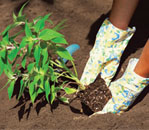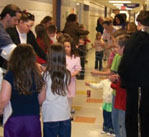 |
|
 |

Discover Math in Everyday Activities For many students, math makes more sense—and is more fun—if they study it in the context of everyday activities. The key goals of this strategy, Finding Math, are to engage students in math through activities they already enjoy, build their problem-solving and collaboration skills, increase their desire to learn, and ultimately extend their understanding of math. For example, a cooking activity enables students to use math by measuring ingredients, comparing measurements of liquids and solids, converting between standard and metric systems, and reducing or enlarging a recipe’s yield. This activity can be easily adapted to students’ school-day math skills. You might have younger students use measuring cups to compare and estimate volume as they make a healthy snack. Older students can practice with fractions and multiplication to double or triple a recipe. A vegetable garden also provides wonderful opportunities for Finding Math activities in expanded learning programs. Students can measure the garden space and individual areas within the bed. Once the garden is planted, they can track the growth of their plants over time, count and weigh the yield, and compare their harvest to that of other students. You can also incorporate science into the gardening project and teach students about photosynthesis and the role of bees and butterflies in plant growth. As an added benefit, the physical exercise of gardening will provide students a release after the school day. Parents and guardians can also participate in Finding Math activities. Parents with young children who are just learning number recognition and counting can teach them to recognize bedtime on a digital clock. Parents can count clouds, birds, or squirrels with their children. Parents can also use street addresses and house numbers to reinforce older students’ recognition of larger numbers and to teach them about odd and even numbers. Research suggests that the best math activities are based on students’ interests, incorporate physical activity and social interaction, and provide meaningful learning for students. By providing opportunities to learn about math outside the classroom, you can help build students’ understanding of math concepts and increase their desire to learn. For more information about finding math activities, visit the math section of the National Center for Quality Afterschool’s Afterschool Training Toolkit. |
The SEDL National Center for Quality Afterschool helps state education agencies and local practitioners develop high-quality programs for academic enrichment as well as youth development activities. |

| 
Math Lesson Plans This resource has activities for six content areas,
|

|
Lehigh Carbon Community College SHINE After-School Program
|
 |
 |
 |
||||||
Communicating About Math |
|
|||||||
This e-mail was sent by: Editor: Laura Shankland
|
You are welcome to reproduce issues of AfterWords and distribute copies at no cost to recipients. Please credit SEDL as publisher. Link to PDF versions of AfterWords is available here. For additional uses, please fill out and submit a copyright request form. Copyright © 2009 by SEDL. |


